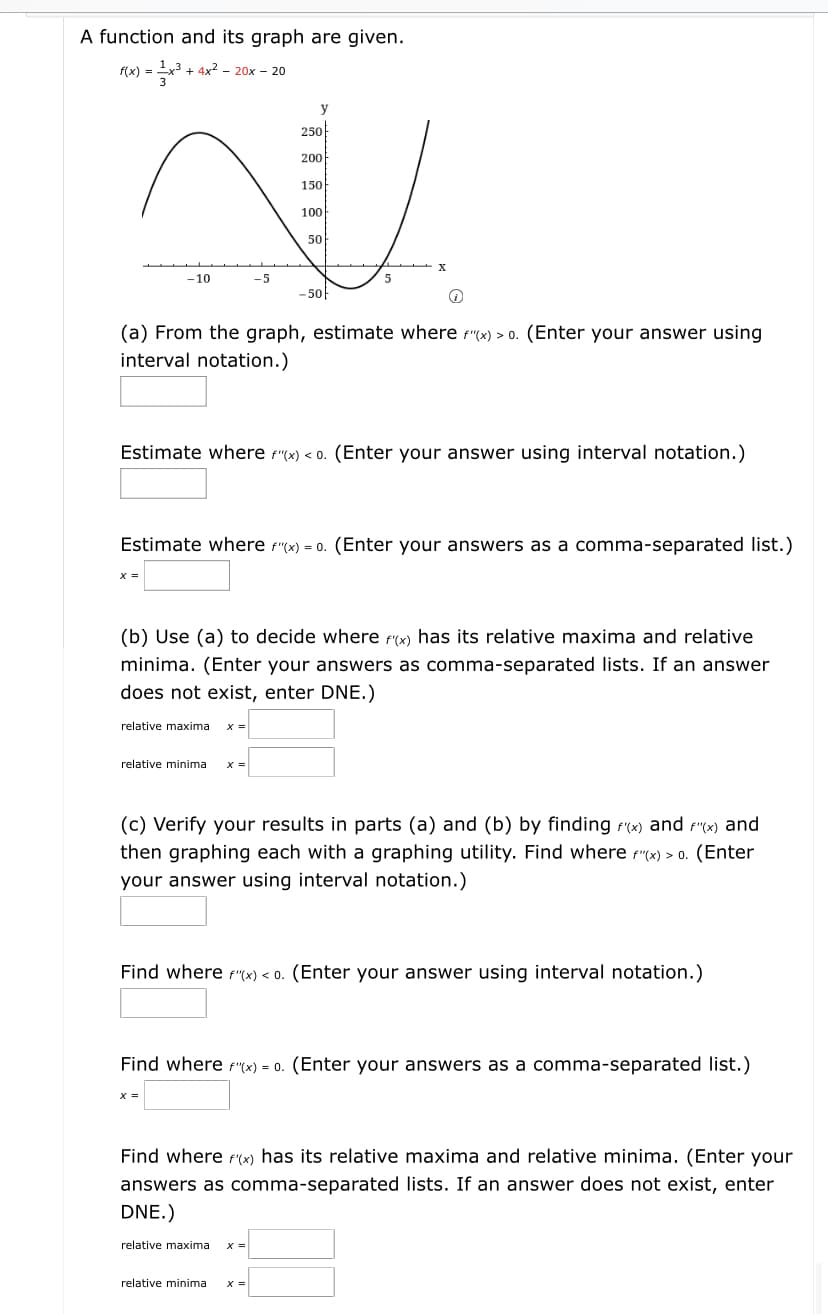A function and its graph are given. rw) - + 4x2 - 20x – 20 250 200 150 100 50 -10 -5 - 50F (a) From the graph, estimate where r"x) > 0. (Enter your answer using interval notation.) Estimate where r"(x) < 0. (Enter your answer using interval notation.) Estimate where r"x) = 0. (Enter your answers as a comma-separated list.) (b) Use (a) to decide where r(x) has its relative maxima and relative minima. (Enter your answers as comma-separated lists. If an answer does not exist, enter DNE.) relative maxima x = relative minima x = (c) Verify your results in parts (a) and (b) by finding rx) and f"(x) and then graphing each with a graphing utility. Find where r"x) > 0. (Enter your answer using interval notation.)
A function and its graph are given. rw) - + 4x2 - 20x – 20 250 200 150 100 50 -10 -5 - 50F (a) From the graph, estimate where r"x) > 0. (Enter your answer using interval notation.) Estimate where r"(x) < 0. (Enter your answer using interval notation.) Estimate where r"x) = 0. (Enter your answers as a comma-separated list.) (b) Use (a) to decide where r(x) has its relative maxima and relative minima. (Enter your answers as comma-separated lists. If an answer does not exist, enter DNE.) relative maxima x = relative minima x = (c) Verify your results in parts (a) and (b) by finding rx) and f"(x) and then graphing each with a graphing utility. Find where r"x) > 0. (Enter your answer using interval notation.)
Algebra & Trigonometry with Analytic Geometry
13th Edition
ISBN:9781133382119
Author:Swokowski
Publisher:Swokowski
Chapter4: Polynomial And Rational Functions
Section4.5: Rational Functions
Problem 54E
Related questions
Question

Transcribed Image Text:A function and its graph are given.
f(x) =
+ 4x2 - 20x – 20
y
250
200
150
100
50
- 10
-5
5
–50
(a) From the graph, estimate where f"(x) > 0. (Enter your answer using
interval notation.)
Estimate where f"(x) < 0. (Enter your answer using interval notation.)
Estimate where r"(x) = 0. (Enter your answers as a comma-separated list.)
(b) Use (a) to decide where f(x) has its relative maxima and relative
minima. (Enter your answers as comma-separated lists. If an answer
does not exist, enter DNE.)
relative maxima
relative minima
(c) Verify your results in parts (a) and (b) by finding r'x) and f"(x) and
then graphing each with a graphing utility. Find where f"(x) > o. (Enter
your answer using interval notation.)
Find where f"x) < 0. (Enter your answer using interval notation.)
Find where f"(x) = 0. (Enter your answers as a comma-separated list.)
Find where r(x) has its relative maxima and relative minima. (Enter your
answers as comma-separated lists. If an answer does not exist, enter
DNE.)
relative maxima
relative minima
Expert Solution
This question has been solved!
Explore an expertly crafted, step-by-step solution for a thorough understanding of key concepts.
Step by step
Solved in 2 steps with 2 images

Knowledge Booster
Learn more about
Need a deep-dive on the concept behind this application? Look no further. Learn more about this topic, calculus and related others by exploring similar questions and additional content below.Recommended textbooks for you

Algebra & Trigonometry with Analytic Geometry
Algebra
ISBN:
9781133382119
Author:
Swokowski
Publisher:
Cengage

Algebra & Trigonometry with Analytic Geometry
Algebra
ISBN:
9781133382119
Author:
Swokowski
Publisher:
Cengage